|
< Earlier Kibitzing · PAGE 2 OF 2 ·
Later Kibitzing> |
| Sep-21-16 | | goldfarbdj: I saw Qe4+ c6, but completely missed the Rb8 shot. @al wazir: Qxc6 is not actually mate, because the king has d8 as a flight square. White has Bh4+, winning further material, though. |
|
| Sep-21-16 | | mqhelisi: i see my mistake was 25. Rb8 thinking ...Rxb8 26. Qe4+ Rb7 27.b3 with h3/Bxc7 etc coming i missed that he is an exchange down and the back row is compromised so my 25 and 26 were reversed |
|
| Sep-21-16 | | AlicesKnight: 25.Rb8+ looks possible. 25....Rxb8 allows 26.Nxd7 because the White Q is no longer exposed, while 25.... Kxb8 allows Nxd7 with check, gaining a tempo. But White must beware counters against the back rank. What happened? - yes of course, it needs preparing. |
|
| Sep-21-16 | | agb2002: White has a knight and a pawn for a rook.
Black threatens to take twice on e5 to play Qd1#. The first idea that comes to mind is 25.Rb8+ to deflect the pinning rook or to attract the king into the knight's range: A) 25... Kxb8 26.Nxd7+
A.1) 26... Kb7 27.Qb5+ Kc8 (27... Ka8 28.Qc6#) 28.Ne5 A.1.a) 28... Re7 29.Qa6+ Kd8 (29... Kb8 30.Nc6+ Ka8 31.Qxa7#) 30.Nc6+ and 31.Nxe7 wins. A.1.b) 28... Re6 29.Qd7+ and 30.Qxe6 wins.
A.1.c) 28... h4 29.Bf4 and 29... Rh5 is impossible due to 30.Qxe8+. A.1.d) 28... Bxe5 29.Bxe5 + - [Q+B+P vs 2R]. For example, 29... Rhf8 30.f4 gxf3 31.gxf3, etc. A.2) 26... Kc8 27.Ne5
A.2.a) 27... Re7 28.Qa6+ as in A.1.a.
A.2.b) 27... Re6 28.Qe4 looks winning. For example, 28... Kb8 29.Nc6+ and 30.Qxe6, or 28... c6 29.Qc4 Rhe8 30.Qa6+ Kd8 31.Bh4+ Kc7 32.Qxa7+ Kd6 33.Qxg7 Rxe5 34.Bg3. A.2.c) 27... h4 28.Bf4 Rh5 29.Qa6+ Kd8 (29... Kb8 30.Nc6+ Ka8 31.Qxa7#) 30.Qd3+ Kc7 (30... Ke7 31.Qd7+ Kf6(8) 32.Qf7#) 31.Qd7+ and 32.Qxe8 wins. A.2.d) 27... Bxe5 28.Bxe5 as in A.1.d.
A.3) 26... Ka8 27.Qe4+ c6 28.Qxc6#.
B) 25... Rxb8 26.Qe4+
B.1) 26... c6 27.Nxd7 Rc8 (27... Rb(h)e8 28.Qxc6+ wins) 28.Qa4 or 28.h4 + - [Q+N+P vs 2R]. B.2) 26... Rb7 27.Nxd7 + - [Q+N+P vs 2R] (27... Bxb2 28.Nc5). |
|
| Sep-21-16 | | Once: Fritzie confirms that both 25. Qe4+ and 25. Rb8+ work. 25. Qe4+ is the stronger of the two at +11.28, but 25. Rb8+ is a none too shabby +5.95. The explanation of the difference is this ...
After 25. Rb8+, the key line is 25...Kxb8 26. Nxd7+ Kc8 27. Ne5 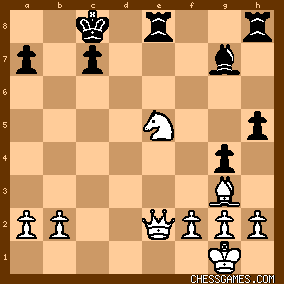
click for larger viewWhite has grabbed material but has to nursemaid his vulnerable knight, which is pinned against the white queen and a back rank mate. That ought not to be too much of a problem if white can flick in f4. White should win this after a few adventures. Tartakover's improvement is the zwischenzug 25. Qe4+. This forces black to add in 25... c6. Then comes
26. Rb8+ Kxb8 27. Nxd7+ Kc8 28. Qxc6+

click for larger viewWhite has a mating attack starting with 28...Kd8 29. Bh4+ I suppose the main difference between the two lines is what happens after black plays Kc8. In the 25. Rb8+ line, white gets to here after 26...Kc8 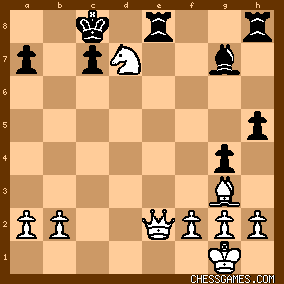
click for larger viewWhite has grabbed material, but now has to scrabble around to save his paratrooper knight. Compare with the position after 27...Kc8 in the 25. Qe4+ line: 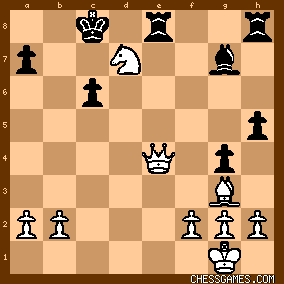
click for larger viewThe only thing that is different is that the white queen is a little further up the board and the c pawn has moved from c7 to c6. But that makes all the difference. In this position, white doesn't have to retreat. He can keep on attacking with Qxc6+ followed up (after Kd8) by Bh4+ or Qc7+. I'm kicking myself. I saw both 25. Qe4+ and 25. Rb8+ but decided that 25. Rb8+ was good enough. In human mode, I didn't stick with 25. Qe4+ long enough to appreciate why it was markedly better. Great puzzle. |
|
| Sep-21-16 | | leRevenant: As per <goldfarbdj> |
|
| Sep-21-16 | | saturn2: I settled on 25 Rb8+ and did not worry about black winning the pinned knight on e5, for white would win the a pawn and has the initiative afterwards. |
|
| Sep-21-16 | | gofer: I saw 25 Rb8+ Kxb8 26 Nxd7+ Kc8 and decided I didn't like the options it gave black. So I looked around for something better and found the queen check first, because this does not allow Kxb8 as a response as it loses very quickly! So black is forced to play Rxb8 at which point black is forced to defend Pc6, so again all forced and less complicated... <25 Qe4+ c6>
<26 Rb8+ ...>
26 ... Kxb8
27 Nxd7++ Kc8 (Ka8 28 Qxc6# or Kb7 28 Nc5+ Kc8 (Kb6 Qb4# or Ka8 Qxc6#) 29 Qxc6+ Kd8 30 Qc7#/Qd7#) 28 Qxc6+ Kd8
29 Bh4+ 
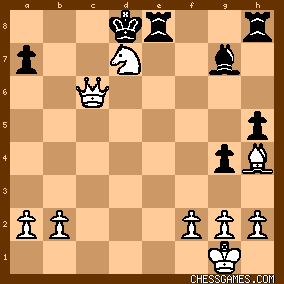
click for larger view<26 ... Rxb8>
<27 Nxd7 Rbc8>
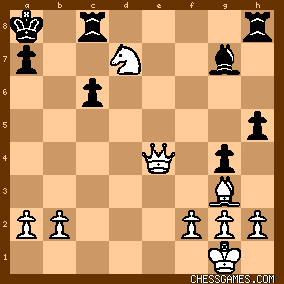
click for larger viewOkay, we are winning, but how do we win!
I have two thoughts;
a) keep attacking...
28 Qa4
b) start defending...
28 h4
What do our silicon friends say to this?
~~~
<Once> what does Fritz like? |
|
| Sep-21-16 | | whiteshark: 25.Rb8+ was good enough for me. 25.Qe4+ is only more subile/better if black wouldn't have resigned. |
|
| Sep-21-16 | | morfishine: As for me, a cup of coffee, glance at the board, White plays <25.Rb8+> and its off to work ***** |
|
Sep-21-16
 | | keypusher: <Once> <Great puzzle.> Great post! |
|
| Sep-21-16 | | Oxspawn: I saw
25. Rb8 Kxb8
26. Nxd7+ Kc8 and
the difficulty as the white knight is under attack and white is also vulnerable to a back rank mate. I thought it would mean playing defensively
27. Qd1 followed by h3 to give the king an escape route.
I not only failed to consider 25. Qe4+ but when I played the game through failed to see why it was played. Learnt a lot from the comments today. Thanks. |
|
| Sep-21-16 | | catlover: I am with the 24. Rb8+ crowd. I kicked myself when I saw how playing 24. Qe4+ first improves the line. Somebody (Emmanuel Lasker?) once said, "When you see a good move—wait! Don't play it! Look for a better one." |
|
| Sep-21-16 | | RKnight: <Once: After 25. Rb8+, the key line is 25...Kxb8 26. Nxd7+ Kc8 27. Ne5>, yes but looking a little deeper 27...Re6, 27. f4 gf(e.p.), 28. Qf3 Bxe5, 29. Rxe5 Rxe5, 30 Qa8+ picks up the other rook. This is without the benefit of an engine, so I may have overlooked something, but it seems that both 25. Rb8+ and 25. Qe4+ are totally convincing wins. |
|
| Sep-21-16 | | Once: <Rknight> Both moves ought to win for white. The difference is that Tartakover's line gives white a continuing strong attack. The alternative line gives white a material advantage, but not necessarily a quick route to a handshake. Taking your line, this is the position after 27... Re6 28. f4 gxf3 29. Qxf3: 
click for larger viewNow Black could indeed capture twice on e5, which would fall into the Qa8+/ Qxh8 trick. But he doesn't have to do that. He could capture once on e5 and then defend his h8 rook, say with 29...Bxe5 30. Bxe5 Rhh6 or Rhe8 or Rd8. That could give us a position like this (after 30...Rhh6): 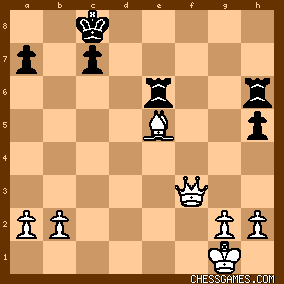
click for larger viewWhite really should win this one, but it's not an obvious victory. Black may even be able to build a fortress by parking his rooks on a pair of white squares where the dark-squared bishop can't see them. Compare with the 25. Qe4+ lines where black faces an ongoing attack against his king. I think it's safe to say that both moves win, but the game line wins more convincingly and faster. |
|
| Sep-21-16 | | Clodhopper: Felt very smug about having found the best move, 25 Rb8+..... only to check the game and find out it wasn't the best move. Must be Wednesday! |
|
| Sep-21-16 | | Once: <gofer> Fritzie says 28. Qa4 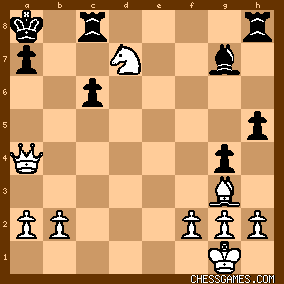
click for larger viewwhen black has no good way of defending against Nb6+. The black rook on c8 can't afford to run away because of Qxc6+. As soon as white eliminates one of the two rooks his queen will have great fun zooming around the board snapping up loose pieces. |
|
| Sep-21-16 | | kevin86: Now white can win the black queen and save his own. |
|
| Sep-21-16 | | YouRang: <Once> Good explanation of the difference between 25.Rb8 and 25.Qe4+. <I'm kicking myself. I saw both 25. Qe4+ and 25. Rb8+ but decided that 25. Rb8+ was good enough.> I would argue (or agree) that 25.Rb8+ actually *was* good enough. The paratrooper knight seems to escape black's clutches simply by jumping back to e5. It's pinned, but it doesn't appear that black has the time or resources to make the pin stick. But as you point out, <25.Qe4+> is the stronger move. |
|
Sep-21-16
 | | doubledrooks: 25.Qe4+ c6 26.Rb8+ works for me. |
|
| Sep-21-16 | | BOSTER: Everybody'd see 25.Rb8 and stop evaluation.
But Tartakover's 25.Qe4, in-between move , is much thinner-like thin ice.
To see 25.Qe4 is not easy, you need a patience, and always follow " looking for the better move". |
|
| Sep-21-16 | | dzechiel: Like <Once>, I saw both 25 Qe4+ and 25 Rb8+. Since both combinations contained the rook check, I persuaded myself that I should play it first in order to eliminate any counter-play opportunities by black. :( |
|
| Sep-21-16 | | Cheapo by the Dozen: The trick, as previously noted, is noticing that Qe4+ is needed to prepare the Rb8+ shot. My notes were
-------------------
Rb8+ obviously gets queen for rook and knight, but that just leaves material fairly even. Also, if White's knight moves, then a Black rook at e8 can skewer the White queen against the e1 mating square. My fix is to interpolate Qe4+, as in 25 Qe4+ c6
26 Rb8+ Kxb8
27 Nxd7++ Kc8
28 Qxc6+ Kd8
29 Bh4+
and Black is destroyed.
The only serious alternative I see for Black is to play ... Rxb8, losing queen for rook initially but hoping to recover via the e-file skewer. However, 25 Qe4+ c6
26 Rb8+ Rxb8
27 Nxd7 Rhe8
28 Qxc6+ Rb7
29 Nb6+
wrecks Black's whole day. |
|
| Sep-21-16 | | BOSTER: My Q who saw 25.Qe4+.
Why you should not play this? |
|
| Sep-21-16 | | YouRang: <Cheapo by the Dozen: The trick, as previously noted, is noticing that Qe4+ is needed to prepare the Rb8+ shot.> I wouldn't say "needed"...
<Rb8+ obviously gets queen for rook and knight, but that just leaves material fairly even.> Actually, it's a queen for a rook, and white is winning handily (just not *as* handily as the 25.Qe4+ line). As noted above: <25.Rb8+ Kxb8 26.Nxd7+ Kc8 27.Ne5  > :-) > :-) |
|
 |
|
< Earlier Kibitzing · PAGE 2 OF 2 ·
Later Kibitzing> |





